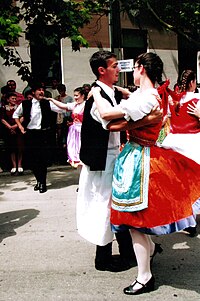Zigeunerweisen
From Wikipedia, the free encyclopedia Zigeunerweisen (Gypsy Airs) (Op. 20) is a piece in C minor for violin and orchestra (or violin and piano) written in 1878 by the Spanish composer and virtuoso Pablo de Sarasate and premiered during the same year in Leipzig. It is based on themes of the Roma people, specifically the rhythms of the csárdás. Zigeunerweisen is of approximately ten minutes' duration. Sarasate's most popular composition and a favorite among violin virtuosi, the work has remained a staple on records at least since Sarasate himself committed it to wax in 1904; a few of the masters who have recorded it in more recent years would include Nigel Kennedy, Zino Francescatti, Jascha Heifetz, Ivry Gitlis, Itzhak Perlman, Kyung-wha Chung, Gil Shaham, Midori Goto, and Anne-Sophie Mutter. String bassist Edgar Meyer recorded a version with Béla Fleck and Mike Marshall on the album Uncommon Ritual. It was featured in the 2002 film Together, and it provided both the title and much of the soundtrack for Seijun Suzuki's 1980 film Zigeunerweisen. Much of Zigeunerweisen also features in the Hong Kong film Kung Fu Hustle. Composition
Zigeunerweisen is in one movement but can be divided into four sections based on the tempi: Moderato: an imposing, virtuosic introduction with slow majestic energy by the orchestra, then a little softer by the violin itself.
Lento: the violin plays in lugubrious lento 4/4. This section has an improvisational quality; the melody, which essentially consists of pairs of 4-bar phrases, is punctuated with difficult runs and other technically demanding figures, including flying spiccato and ricochet bowings.
Un poco più lento 2/4 — The muted soloist plays a melancholic melody with the so-called reverse-applied dotted note (1/16 + dotted 1/8 rhythm).
Allegro molto vivace 2/4 — At this point, the piece becomes extremely rapid. The challenging solo part consists mainly of long spiccato runs, along with double stops, artificial harmonics and left-hand pizzicato.
Csárdás
From Wikipedia, the free encyclopedia Csárdás (Hungarian pronunciation: [ˈtʃaːrdaːʃ]) is a traditional Hungarian folk dance, the name derived from csárda (old Hungarian name for a pub. It originated in Hungary and was popularized by Roma music (Cigány) bands in Hungary and neighboring lands of Serbia, Slovakia, Slovenia, Burgenland, Croatia, Carpathian Ruthenia, Transylvania and Moravia, as well as among the Banat Bulgarians, including those in Bulgaria.[1]
 
夏得西
維基百科,自由的百科全書 夏得西(查達斯、恰爾達什,匈牙利語:Csárdás,發音為 char'dash,源自 csárda,意為客棧),是匈牙利民俗舞蹈。起源於馬劄爾人及吉普賽人。 夏得西源自18世紀時的verbunkos,起初為匈牙利陸軍徵兵者所使用的舞蹈音樂。它的特色是節奏的變化:慢與快。以慢節奏(lassú)開始,結束於快節奏(friss)。另外有其他種類的節奏變化,稱為ritka csárdás、sürü csárdás、szökös csárdás。音樂節拍有2/4拍或4/4拍。 舞者包含男與女。女舞者著傳統寬裙,通常是紅色的裙子。當女舞者旋轉時,寬裙會形成別具特色的形狀。 古典音樂作曲家常會將夏得西風格融入他們的作品,這些作家有李斯特、布拉姆斯、約翰·史特勞斯、柴可夫斯基等。 來自“http://zh.wikipedia.org/wiki/%E5%A4%8F%E5%BE%97%E8%A5%BF”
|